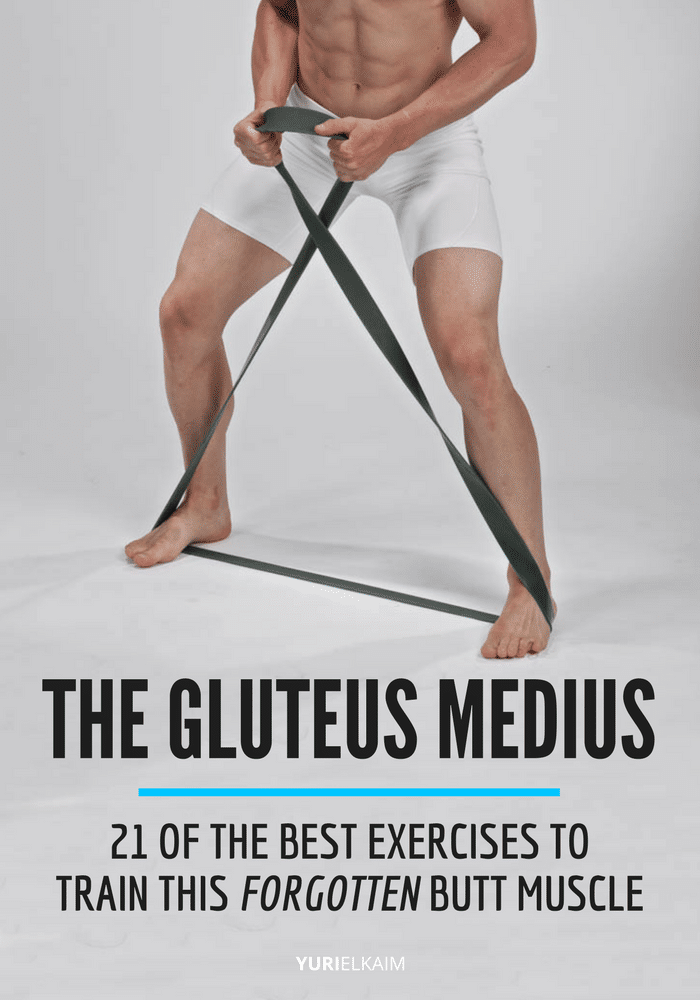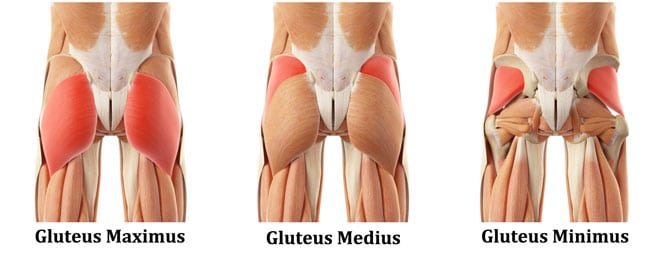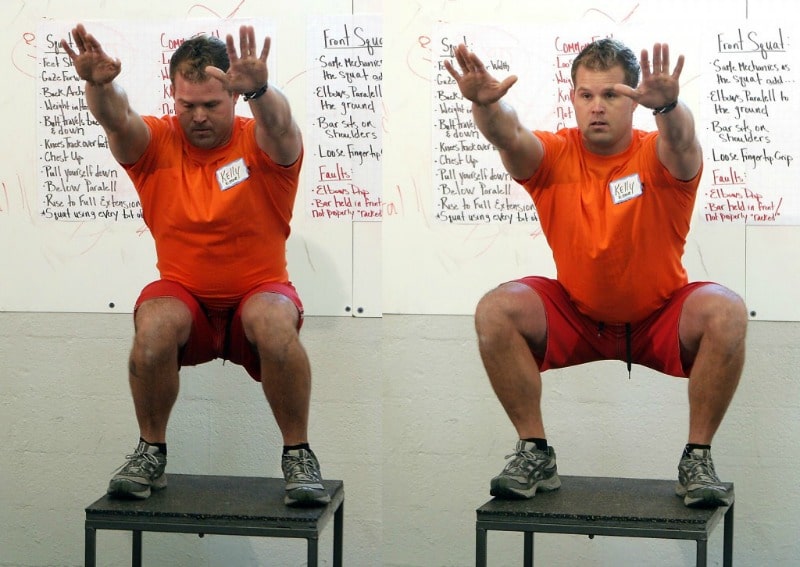Let’s face it: when you think about your glutes, you probably only think about what they look like.
Are they lifted and toned, or do they need a little work?
In this article
While aesthetics are important (and likely one of the major reasons you work out), there are some muscles in your body that can do much more than just make you look good. In fact, they can solve a lot of your problems.
One of those muscles is the gluteus medius.
Gluteus Medius: The Forgotten Butt Muscle
When most people think about the glutes, they’re really thinking about the gluteus maximus, which is the largest of the muscles in the gluteal group.
But the glutes actually are composed of three muscles: the gluteus maximus, gluteus minimus, and gluteus medius.
The gluteus medius is the muscle we’re focusing on here, since it often doesn’t get the attention it deserves.
It sits above the gluteus maximus and attaches to your hip joint, where it provides several important functions that go beyond just giving your bum a lift (although it’s great for that, too).
Benefits of Training the Gluteus Medius
If you’re a runner or are new to workouts or glute exercises in general, your gluteus medius muscle is probably weak. In fact, it might be so weak it doesn’t even know how to do its job of stabilizing your hips.
And that’s a pretty big deal, because it’s the main muscle involved in stabilizing your hips, as well as rotating them both externally and internally.
When you mainly do a lot of running or walking as your workouts, you’re moving forward in one plane of motion. This causes the gluteus medius to become under-used because you’re not putting any emphasis on extending or rotating.
In turn, once the gluteus medius grows weaker, your hips begin to drop unnaturally, and to compensate your pelvis begins to internally rotate. An example of this is noticing your knees collapsing in toward one another during squats.
Pictured: On the left, the knees collapse inward at the bottom of squat. On the right is the correct knee position.
Essentially, the gluteus medius isn’t strong enough to keep your pelvis from drooping inward.
As you might imagine, this can create a whole host of problems such as iliotibial (IT) band syndrome, low back pain, and knee injuries to name a few.
When you begin to focus on training and strengthening the gluteus medius, you’ll notice improved stride and most likely a reduction in back and knee pain. Plus, you’ll help your pelvis stay stabilized in its optimal position, so you don’t have to worry about getting injured during lower-body workouts or runs.
21 of the Best Gluteus Medius Exercises
Just doing squats won’t cut it when it comes to strengthening this under-appreciated muscle. To really engage the gluteus medius, you have to focus on movements that abduct and stabilize the hips, outer thighs, and glutes. Ideally, these will involve some sort of resistance to strengthen the medius.
Some of the best exercises for doing just that are below. Plus, I’ve included two bonus workout ideas.
Before getting started, make sure you run through a quick 5- to 10-minute dynamic warm-up (get some great ideas here) to get your blood pumping.
1. Side-Lying Clam
Level of difficulty: Beginner
Side-lying clams look like they’re a piece of cake to work through. After all, you’re lying down, so how hard can they be? Prepare to be amazed at the burn this simple exercise creates.
One tip: be sure to keep your core pulled in as you engage your glutes to lift your knee, and don’t let your body roll backward as you try to lift your knee.
2. Bodyweight Wall Abductor (0:45)
Level of difficulty: Beginner
If you’re new to training the gluteus medius, bodyweight wall abductors are another excellent exercise the start building glute strength. Because you’re holding on to a wall for support, it helps you really focus on squeezing your glutes together and keeping your legs straight.
3. Mini-Band Seated Clam
Level of difficulty: Beginner
The mini-band seated clam gets your glutes acquainted with mini bands (and the deep burn you’ll feel in your glutes when you start to use them, due to the increased glute activation they cause). These are also an excellent and simple way to add resistance to the clam movement.
4. Mini-Band Side-Lying Clam
Level of difficulty: Beginner
The mini-band side-lying clam adds a bit of resistance to the regular clam by adding a band, giving you an extra burn throughout your outer hips and gluteus medius. Be sure to keep your core tight and glutes engaged, even when it really starts to burn.
5. Lateral Leg Raise
Level of difficulty: Beginner
The lateral leg raise is a classic exercise to target the outer thighs and gluteus medius. However, just because it’s an oldie doesn’t mean it isn’t a goodie!
One of the best things about this exercise is that it can be done anywhere you can find a floor, or you can even elevate yourself on a bench like in this video for an extra challenge.
6. Stability Ball Wall Abductor
Level of difficulty: Beginner
This exercise is not only great for strengthening the gluteus medius, but also for strengthening the stabilizer muscles throughout your legs and glutes, which will help you improve balance and mobility.
7. Resistance Band Wall Abductor (3:00)
Level of difficulty: Beginner
Adding a resistance band to wall abductors is an excellent way to up the burn throughout your gluteus medius and outer thighs, while also improving your balance as your work to maintain correct form against the pull of the band.
8. Mini-Band Hip External Rotation
Level of difficulty: Beginner
This is a fantastic exercise for runners looking to activate the gluteus medius while also working the stability muscles throughout the knees and thighs. This will help improve your agility, forward, and lateral power by improving your strength and stride.
9. Cable Hip External Rotation
Level of difficulty: Beginner
This exercise is excellent for improving your ability to externally rotate your hips, since it puts constant tension on the muscles in the glutes responsible for rotation. When you have the hip mobility, strength, and flexibility this exercise helps improve, almost every lower body movement, like bending over and picking something up, will become easier and more fluid.
10. Mini-Band Side-Lying Leg Raise
Level of difficulty: Beginner-intermediate
Adding a mini band to your leg raises is going to create a major burn throughout your outer hips and gluteus medius. It’s also going to create slightly more glute activation than regular raises, since the glutes are under constant tension from the band.
11. Cable Standing Lateral Raise
Level of difficulty: Beginner-intermediate
Cable standing lateral raises are similar to mini-band side-lying raises, and are a great alternative if you find yourself lacking a band or would like to do more standing work. This exercise not only challenges your outer thighs and gluteus medius, but also your core stability muscles to help improve your balance.
12. Mini-Band Standing Lateral Raise
Level of difficulty: Beginner-intermediate
Mini-band standing lateral raises will have your outer thighs and glutes on fire. You might also feel quite a bit of tension in your obliques as they work to help lift your leg against the tension of the mini band.
13. Mini-Band Lateral Hip Walk
Level of difficulty: Beginner-intermediate
Lateral band hip walks look simple, but don’t be fooled. Once you get started with them, you’ll see that just by adding a band to this back-and-forth movement, your glutes will be activated and burning like crazy.
As a bonus, this video also shows you how you can use a regular resistance band for this exercise if you don’t have a mini band.
14. Resistance Band Lateral Walks (7 Ways)
Level of difficulty: Beginner-intermediate
Lateral walks are perfect for getting in major glute medius activation, while also activating your outer hips. This video shows you several ways to do them to hit the glutes in different ways, while also showing you how to increase the band resistance through different holds.
Note: Skip to 1:30 to go straight to the lateral walk examples.
15. Mini-Band Linear Diagonal Walking (0:50)
Level of difficulty: Beginner-intermediate
Here is another version of mini-band walking that involves moving in a diagonal and side-to-side direction. This helps hit the gluteus medius while also really working the outer and front of the hips, improving mobility and hip strength.
16. Mini-Band Squat
Level of difficulty: Intermediate-advanced
When you squat, especially if you’re not used to activating your glutes properly, you might end up putting all of the load on your quadriceps. This can lead to muscle imbalances and a failure to really get those glutes working. Adding a mini band essentially forces the glutes to get involved in the movement, resulting in better glute-shaping results.
As a bonus, you’ll also get some awesome tips in this video on how to squat correctly to get the most booty-building benefits.
17. Mini-Band Lateral Squats
Level of difficulty: Intermediate-advanced
Mini band lateral squats take regular mini-band squats up a notch by having you move from left to right. This gets your outer hips and core more involved to improve stability, and build lean legs from your glute medius down to your toes.
18. Quadruped Fire Hydrant
Level of difficulty: Intermediate-advanced
Quadruped fire hydrants are another exercise that is excellent for strengthening the gluteus medius while also improving external hip rotation. It also helps improve your hip stability and core strength, which ultimately helps improve your balance.
19. Mini-Band Quadruped Fire Hydrant
Level of difficulty: Intermediate-advanced
This exercise will add a bit of resistance to your regular fire hydrant, and have your outer glutes and thighs really feeling the burn. Plus, you’ll get quite a few tips on how to position your hips correctly to get maximum results from this exercise.
20. Donkey Kick
Level of difficulty: Intermediate-advanced
Donkey kicks are amazing for targeting the upper portion of the glute medius, which will help give you that coveted butt lift. You’ll also get a little core engagement with the exercise as you balance with one leg in the air. To really feel this one, concentrate on those glutes to be sure they engage.
21. Mini-Band Quadruped Donkey Kick
Level of difficulty: Intermediate-advanced
If you thought donkey kicks couldn’t burn any more, think again. Adding a mini band to this movement will have all of your glute muscles on fire, plus you’ll also get some hamstring engagement as well.
Gluteus Medius Workout Ideas
Below are a couple workout ideas to get you started on your journey to strong, sculpted glutes and thighs. These are merely suggestions to help you build an effective workout – feel free to switch up the exercises based on your fitness level.
For example, one template for workout design that you could use would be to pick 5 exercises of your choice from the list above, plus 5 cardio exercises to do in-between each exercise.
Then, go through the circuit 2 to 3 times, with no rest between exercises and a 60-second rest between circuits.
Gluteus Medius HIIT Workout Example
- Mini-band diagonal walking (12 reps each leg)
- Skater jumps (15 reps total)
- Donkey kicks (10-15 reps each leg)
- High knees (40-50 reps)
- X-band squats (10-15 reps)
- Burpees (10 reps)
- Side-lying clams (10-15 reps each leg)
- Side shuffles (20 reps)
- Mini-band quadruped fire hydrants (10-15 reps each leg)
- Jumping jacks (20 reps)
- Rest for one minute, repeat 2 to 3 times through.
Gluteus Medius Finisher Option
Another option to sneak in a decent glute medius workout is to add in a fisher-style workout to your routine.
This finisher can be added to the end of your workouts to get in an extra burn in your glutes. Do 50 seconds of each exercise without stopping and repeat for 2 to 3 rounds, with a 60-second break between rounds.
- Mini-band quadruped donkey kicks (10-15 reps each leg)
- Mini-band side-lying clams (10-15 reps each leg)
- Mini-band side-lying leg raise (10-15 reps each leg)
How to Find the Right Mini Band
Since many of these exercises require mini bands and/or resistance bands, you’ll probably want to get your hands (thighs?) on some.
An awesome brand to consider is Rogue Fitness, which offers several resistance levels of bands, including different packages for different fitness levels. If you’re new to bands, I’d recommend starting with a single band for beginners, then progressing to the package options so you can get a feel before you buy.
Alternatively, you can find bands just about anywhere online, with Amazon being a great option.
Strong Glutes, Strong Body
As you can see, sometimes focusing on training certain muscle groups in the body can have benefits far and beyond getting toned.
After all, who doesn’t want a side of stability and strength alongside their tight bum?
Get this FREE Fat-Burning Workout
Blast fat and sculpt muscle with this strength and interval cardio combo workout.
This downloadable program includes an instructional video, workout tracker, and follow-along audio. A $29 value – it’s yours FREE!
Get your copy of the Fat Blaster right now by clicking the image below!



